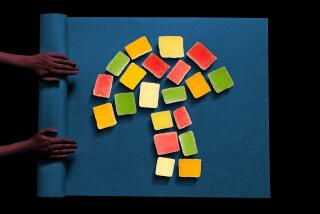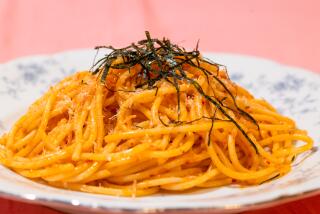Be Kind to Your Mushroom
- Share via
When it comes to cooking mushrooms, Jack Czarnecki pretty much wrote the book. Two books, in fact.
The owner of a couple of mushroom-oriented restaurants--Joe’s and Bistro 614--in mushroom-crazy Pennsylvania and author of “Joe’s Book of Mushrooms” (Atheneum: 1988) and “A Cook’s Book of Mushrooms,” (Artisan: 1995) Czarnecki has some definite opinions about how mushrooms should be cooked.
First, he says, any mushroom benefits from his all-purpose flavoring mixture: a little salt, a little sugar and a little soy sauce. “Salt enhances the flavor, but if you use too much salt, you get a thin metallic character,” he says. “If you use all soy, then the soy becomes too predominant and the mixture tastes like a stir-fry. Then you have to balance the two, so finally you add a little pinch of sugar. Soy and salt have a little metallic edge and the sugar rounds out those flavors and makes them richer and fuller.”
That may seem odd to those who are used to the typical mushroom flavorings of garlic, parsley and lemon juice, but certainly not as odd as what he has to say about that classic mixture: “When you add garlic to mushrooms, you tend to get something that tastes like garlic. And you never add lemon to mushrooms, except for maybe chanterelles. The flavor just overpowers anything else. Parsley? I guess parsley’s OK, but savory is a lot better. That’ll make even ordinary mushrooms taste good.”
Beyond that, he says, you should let the variety of mushroom dictate the seasoning. “The thinking behind my way of cooking mushrooms is that you want to taste the mushrooms. And even with wild mushrooms, many of them have fairly subtle flavors. The distinctive characteristics seem to be in background.”
Take morels, for example. Czarnecki says it’s critical to cook them with onions and butter and that green pepper and caraway are good flavors to bring out the distinctive qualities. He says he even puts some caraway seeds in the liquid when he’s reconstituting dried morels.
Chanterelles can be cooked with a little citrus--either lemon juice or even orange juice. And boletes? Well, boletes are good enough that they don’t need anything but onion and butter.
As far as commonly available domestic mushrooms are concerned, Czarnecki says his favorite is the fresh shiitake. “It has a kind of haunting smoky flavor to it that is really unique. The other thing about shiitake--and I don’t know why this is true--but it has the uncanny ability to exert its own flavors even when paired with aggressive herbs and spices. It’s saying ‘OK, you’re going to throw this at me, here’s what I’m going to do.’ They are really wonderful mushrooms.”
He’s not so high on the current faves, portobellos. “It’s nothing more than an overgrown crimini, not that that’s a bad thing,” Czarnecki says. “I think with the portobello, the thing that really makes a difference is its size. You can really sink your teeth into something like that. That’s why they’re grilled so often.”
Czarnecki is not afraid to explode a few of what he views as myths about mushroom cooking.
“People generally say that criminis are better-tasting than white button mushrooms, but I’m not really convinced of that. I think the only reason that might be true is because criminis tend to be picked at a little more open stage. When mushrooms are open and you can see the gills underneath, that’s when you can find real mushroom flavor.”
Czarnecki prefers to cook mushrooms gently, with a little water. “Cover them and let them steam so the mushrooms begin to lose their water; that makes them wonderfully fragrant and they’re totally cooked. It usually doesn’t take more than five or 10 minutes.”
And speaking of water and mushrooms, Czarnecki says to forget that old wives’ tale about never washing mushrooms. “It’s not true at all. What I found is best with mushrooms is to keep them cold until you’re ready to use them, then rinse them under running water.
“It’s a myth that mushrooms are going to absorb all this water. People say that mushrooms are sponges. Well, that’s true, but they’re already 90% water. How much more can they absorb?
“The thing you really don’t want to do is wash them and then put them back in the refrigerator. You’ll get surface oxidation. The mushrooms will change color. Basically, they’ll begin to rot.”
WILD MUSHROOMS TUSCAN STYLE
Be sure to use the right size skillet for this recipe. If it’s too big, the juices will evaporate too quickly. From Jack Czarnecki’s “A Cook’s Book of Mushrooms” (Artisan: 1995).
2 tablespoons extra-virgin olive oil
1/2 cup sliced or chopped onion
1/2 pound fresh button mushrooms or any variety of domestic or wild mushrooms
1 teaspoon salt
1 teaspoon sugar
1 teaspoon soy sauce
1/2 teaspoon dried savory
2 teaspoons cornstarch mixed with 1/4 cup cold water
Heat oil in 8- or 9-inch skillet over medium heat. Add onion and saute until slightly browned, 2 or 3 minutes. Add 1/2 cup water, then add mushrooms and cover skillet. Simmer for 30 minutes. Mushrooms will greatly reduce in size and be completely covered with liquid.
Add salt, sugar, soy sauce and savory and stir. Taste and add more salt, sugar or soy sauce if necessary. Simmer another 5 minutes, then stir in cornstarch mixture, blend until thickened and serve.
Makes 4 servings.
Each serving contains about:
92 calories; 676 mg sodium; 0 cholesterol; 7 grams fat; 7 grams carbohydrates; 2 grams protein; 0.57 gram fiber.
SAUTEED CEPES A LA BORDELAISE
This classic recipe from “The French Menu Cookbook” by Richard Olney (Simon & Schuster, 1970) breaks two of Jack Czarnecki’s mushroom cooking rules--it includes both garlic and lemon juice--and it is delicious.
1 pound bolete or crimini mushrooms
3/4 cup olive oil
Salt and pepper
1 tablespoon chopped shallots
1 clove garlic
1 tablespoon fine bread crumbs
2 tablespoons chopped parsley
Juice of 1/2 lemon
Choose small, firm mushrooms that have not completely opened. Larger mushrooms should be reserved for grilling. Wipe each mushroom carefully with damp towel after cutting off stem ends to remove any adhering dirt. Remove stems, slice each in half lengthwise, and cut out and discard any parts that may be wormy. Chop about half of stems fairly fine and reserve. Any heads smaller than whole walnut may be left whole. Cut others into halves, quarters or thick slices.
Heat oil in large skillet, add mushroom and stem pieces, season with salt and pepper, and cook over high flame for about 10 minutes, tossing or gently stirring regularly with wooden spoon. (At beginning, mushrooms must not be too crowded--if pan is not large enough, use 2 pans and additional oil. After initial browning, mushrooms may be combined for final cooking.)
When mushrooms are lightly browned, reduce heat to low, cover and cook another 5 minutes or so. Increase heat to high again, add finely chopped stems, chopped shallots and whole garlic clove and cook, stirring and tossing another 2 or 3 minutes.
Drain off as much oil as possible. (A large quantity of oil is essential for first stage of cooking, but must not remain. Reserve excess oil to fry potatoes.) Reduce heat to low, add bread crumbs and 2/3 of chopped parsley. Stir together and cook over low heat, stirring regularly, until bread crumbs absorb remaining oil. Discard garlic clove. Sprinkle mushrooms with few drops of lemon juice, season with salt and pepper and garnish with remaining chopped parsley.
Makes 4 servings.
Each serving contains about:
398 calories; 91 mg sodium; 0 cholesterol; 41 grams fat; 8 grams carbohydrates; 3 grams protein; 0.90 gram fiber.
WHITE CHEESE RAMEKINS WITH MUSHROOM SAUCE (Ramequins au Fromage Blanc Sauce Champignon)
This recipe is from “Savoie” by Madeleine Kamman (Atheneum, 1989).
1/2 pound well-drained fresh white cheese or fine-curd cottage cheese
1/2 teaspoon fennel seeds
3 cups whipping cream
4 eggs
Salt and pepper
3 tablespoons butter
1/3 cup finely chopped very lightly toasted almonds
1 pound sliced mushrooms (chanterelles and oysters preferred)
2 cloves garlic, mashed
2 tablespoons chopped parsley
Puree cheese, fennel seeds, 1 cup cream and eggs in blender until smooth. Taste and season with salt and pepper.
With 1 tablespoon butter, grease 8 (3-ounce) ramekins and coat inside with chopped almonds. Fill each with cheese mixture and place in large roasting plan. Place roasting pan on middle rack of oven and add boiling water to halfway up sides of ramekins. Bake at 350 degrees until skewer inserted in center of ramekin comes out clean, 20 to 25 minutes.
Meanwhile, saute mushrooms in remaining 2 tablespoons butter. Season with salt and pepper and cover to extract mushroom liquid. After 5 minutes, remove cover and let water evaporate completely. Cook until mushrooms are browned, about 5 to 10 more minutes. Add garlic, parsley and remaining 2 cups cream and cook until sauce is thick enough to lightly coat back of metal spoon.
Unmold ramekins onto warm plates and top each serving with sauce.
Makes 8 servings.
Each serving contains about:
457 calories; 264 mg sodium; 246 mg cholesterol; 44 grams fat; 8 grams carbohydrates; 11 grams protein; 0.69 gram fiber.
WILD MUSHROOM SOUP WITH HERBS
If you prefer, you can omit the herb mixture. From “Cooking for All Seasons” by Jimmy Schmidt (Macmillan, 1991).
3 tablespoons butter
2 cups chopped shallots
2 pounds chanterelles or other wild mushrooms, sliced
1 quart chicken stock
1/4 cup chopped fresh basil
1 tablespoon chopped fresh tarragon
1 tablespoon chopped fresh rosemary
1 clove garlic
1 teaspoon lemon zest
2 tablespoons grated aged Asiago cheese
1 cup whipping cream
1/2 cup sour cream
Salt and pepper
1/4 cup Amontillado or Fino sherry
Melt butter in large saucepan over low heat. Add shallots and saute until soft, about 5 minutes. Add mushrooms and saute until browned and have released juices, about 10 minutes. Add stock and simmer until tender, about 1 hour.
Meanwhile, in small bowl, combine basil, tarragon, rosemary, garlic, lemon zest and cheese. Mix into paste. Refrigerate.
Puree soup in blender in batches. Thin with more stock if needed. Strain through coarse sieve into another saucepan. Whisk in heavy cream and sour cream. Adjust salt and pepper and stir in sherry. Return briefly to simmer over high heat. Ladle soup into warm bowls and garnish with herb mixture.
Makes 8 servings.
Each serving contains about:
273 calories; 526 mg sodium; 61 mg cholesterol; 20 grams fat; 14 grams carbohydrates; 8 grams protein; 1.16 grams fiber.
MUSHROOM PIZZA
DOUGH
1 (1 1/4-ounce) package dry yeast
1 cup warm water
1 teaspoon sugar
3 tablespoons olive oil
3 cups flour
1 teaspoon salt
2 teaspoons cornmeal
Stir yeast into warm water. Sprinkle sugar on top and set aside for 10 minutes. Stir olive oil into yeast mixture and set aside.
In large bowl, combine flour and salt. Add yeast mixture and stir with spoon until dough forms ball. Turn out onto floured board and knead 5 minutes. Place in greased bowl, cover and let rise until doubled in bulk, about 1 hour.
Punch dough down and divide in half. Roll each half into 12-inch circle. Place on pizza pan sprinkled with 1 teaspoon cornmeal.
TOPPING
1 1/2 pounds assorted mushrooms, sliced
3 tablespoons olive oil
3 cloves garlic, minced
2 teaspoons minced fresh thyme
Salt and pepper
1 cup grated Parmigiano-Reggiano
Saute mushrooms in olive oil over high heat until lightly browned, about 5 minutes. Reduce heat to medium and add garlic, thyme, salt and pepper and cook another 5 minutes.
Spread mushrooms over prepared pizza doughs and top each pie with 1/2 cup Parmigiano-Reggiano. Bake at 450 degrees until dough is golden and cheese is melted, about 12 to 15 minutes.
Makes 8 servings.
Each serving contains about:
346 calories; 562 mg sodium; 10 mg cholesterol; 15 grams fat; 42 grams carbohydrates; 12 grams protein; 0.80 gram fiber.
More to Read
Eat your way across L.A.
Get our weekly Tasting Notes newsletter for reviews, news and more.
You may occasionally receive promotional content from the Los Angeles Times.










